Olive (Olea europaea L.) of Jerusalem in Palestine - Juniper publishers
Journal of Trends in Technical and Scientific Research
Abstract
The olive (Olea europaea L., Oleaceae) is the most
important fruit tree found before more than 6000 years, which
contributes to the increase of the agricultural national product in
Palestine, and therefore plays a role in increasing the Palestinian
economy. Methodology, we analyzed data on environmental factors of
Jerusalem (East Jerusalem), including climate and bioclimate, using the
bioclimate classification for the earth of Salvador Rivas Martinez
during study period 1993-2012, which we obtained from the Palestinian
Meteorological Station and the same period of olive production (rainfed)
from the Palestinian Central Bureau of Statistics. Result and
discussion, when we used a correspondence analysis (CA), observed that
Jerusalem affected negatively by bioclimate factors as annual
ombrothermicindex and simple continentality index during the years
(1993-1997), whilst, the effect was positive for years (1997-2012), with
a large proportion of the variance explained by axis F1 (96.81%), axis
F2 (2.88%) and axes F1and F2 (99.100%). Furthermore, in Jerusalem, the
optimum of mean monthly temperature for increased olive production is
between 15-200oC, with the result of annual ombrothermic index value
more than 3.5, compensated thermicity index (210/210 to 350/350), simple
continentality index between (15-20). Addition to olive production
favor, where the environmental areas thermomediterranean to
mesomediterranean of thermotype and dry to humid of ombrotype, and
Jerusalem is belonging to mesomediterranean of thermotype and dry to sub
humid of ombrotype.
Introduction
Posture problems in youth is rising right under your
nose. Are you a parent reading this article? Do you suffer from neck or
back pain after a long day at work? Headaches maybe? Did you wake up
with pain? Maybe you didn’t, but the other 65% of working population
did, dose and do go thru their days in discomfort. You don’t stop eating
because you are afraid of cavities? Then why do you expect the
millennial to give up their smart devices? How many children do you see
already in poor state of health? How many do you know personally? Just
like cavities, using smart devices puts us at risk. It’s not about “What
is wrong?” it’s about how are were reacting to it individually? What is
the compelling reason to make a change before becoming the victim of
the consequences?
Methodology
Study area
Jerusalem is a Palestinian city built by the
Canaanite Arabs more than 6,000 years ago, occupied more than 18 times
throughout history, and the last time by Israel in two stages, the first
phase in 1948, was called West Jerusalem, and the second in 1967
(Six-Day War), was called East Jerusalem (people Palestinian area).
Finally came the promise of the unjust US President Donald Trump to
devote the occupation of the city and considered it the capital of
Israel and not the right of the Palestinians, but in fact Jerusalem is
the capital of occupied Palestine and one of the holiest cities in the
world, the United Nations and the international community do not
recognize Jerusalem as the capital of Israel. East Jerusalem is
considered part of the Palestinian territories and is not recognized as a
Jewish state [25], it is 760 meters above sea level and 64km2 , with
coordinates 31.76°N 35.25°E, the city of Jerusalem is located in the
center of Palestine, which is about 1km away from the Mediterranean,
about 11 km from the Dead Sea, bordered on the eastby the city of
Jericho (Jordan Valley, Jordan River and Dead Sea),
and on the west by the towns of Ramle and Lod (Meditrranean
Sea), on the north by Ramallah and from the south Bethlehem and
Hebron cities (Figure 1).
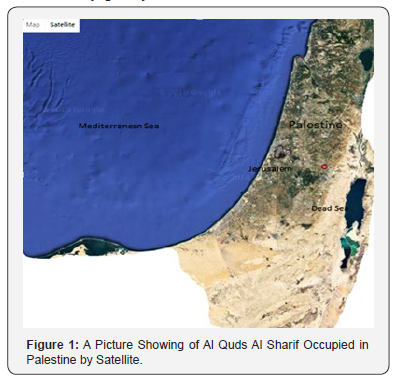
data
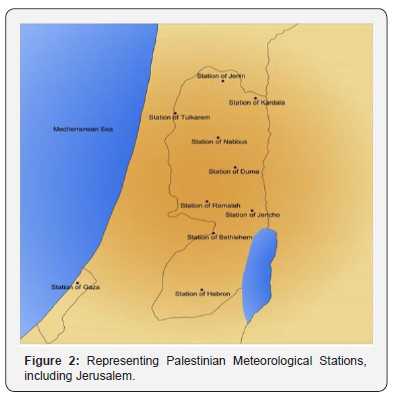
In this paper, both climatic and bioclimatic factors were analyzed,
data were obtained from the Palestinian meteorological
station (Figure 2), with analysis of the olive production data for
the city of Jerusalem obtained by the Palestinian Central Bureau
of Statistics (PCBS) and for the same years of study for both environment
factors and plant production (1993-2012) (Table 1).The analysis of climate and bioclimate factors was done using
the Salvador Rivas Martinez to classification of the earth [26-30],
and climate factors were consisted of mean monthly temperature
(Tm), precipitation (P or ppt) and soil water reserve (R); and bioclimatic
factors or variables as compensated thermicity index (It/
Itc), annual ombrothermic index (Io), simple continentality index
(Ic) and water deficit (Wdf or Df). Annual ombrothermic index, Io
= Pp/ Tp, where is Pp = positive precipitation and Tp = positive
temperature (in this case equivalent to annual precipitation and
mean annual temperature divided by 12, as all the months have an
average temperature above 0; bimonthly summer ombrothermic
index, Is2 = P July + August/T July + August; trimonthly summer
ombrothermic index, Is3 = P June + July + August/T June + July +
August; and simple continentality index (Ic) = Tmax-Tmin, Tmax
= maximum temperature of the averages of the warmest month
of the year, and Tmin = minimum temperature of the averages of
the coldest month of the year; thermicity index, where applicable
compensated thermicity index, It/Itc = (T + M + m)*10, where is
T = average temperature of the months; T = mean monthly temperature;
M = average of the maximum temperature of the coldest
month of the year, and m= average of the minimum temperature of
the coldest month of the year, and P = precipitation of the months
indicated.
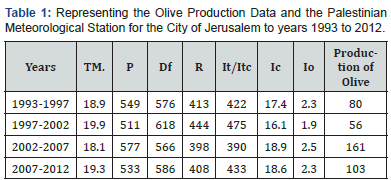
Yield: Kilogram/dunum; T or Tm: Mean Annual Temperature; P or ppt:
Precipitation; R: Soil Water Reserve; Df or Wdf: Deficit water; Io: Annual
Ombrothermic Index; Ic: Simple Continentality Index; and It/Itc: Compensated
Thermicity Index; and Olive Production.
Exploratory data analysis
Further, we also used normality tests for Jarque-Bera and
Shapiro-Wilk to conduct the analysis [31-34], and we applied an
analysis of variance (ANOVA) tests analysis to each of the eight
environmental variables as climate and bioclimate factors and olive
production, four bioclimatic parameters and the three climate
variables or climate factors to obtain the principal component
analysis, factor loading, adjusted r-squared, standardized coefficient
and regression coefficient (R2) to determine the impact of
environmental variables on plant yield. Addition to, exploratory
data analysis was used to determine the most related environmental
variables for the olive, and the XLSTAT software program
were used done. Furthermore, we can use the adjusted r-squared
formula is:

where: N is the number of points in your data sample, and K
is the number of independent repressors; and linear regression
is a way to illustrate the relationship between two variables. The
equation has the form Y= a + b X, where Y is the dependent variable,
X is the independent variable, b is the slope of the line and a
is the y-intercept.
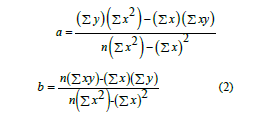
A regression coefficient is the same as the slope of the linear
regression equation, and the formula of the regression coefficient
that is: B1 = b1 = Σ [ (xi – x) (yi – y)] / Σ [ (xi – x)2]. “y” in this equation
is the mean of y and “x” is the mean of x.

Yield: Kilogram/dunum; T or Tm: Mean annual temperature;
P or ppt: precipitation; R: Soil water reserve; Df or Wdf: Deficit
water; Io: Annual ombrothermic index; Ic: Simple continentality
index; and It/Itc: Compensated thermicity index; and olive production.
Result and Discussion
Impact of climate & bioclimate factors on olive production
Principal component analysis (PCA):After we analyzed
the climate and climate factors using the Salvador Rives Martinez
methodology [29,30], and applied the natural tests of Jarque - Bera
and Shapiro-Wilk [31-34], and finally the XLASTAT Software program,
the probability value obtained from the studied variables
tends to be less than 0.05, which is traditionally acceptable. PCA
is used as a in exploratory data analysis, factor loading, standard
deviation, covariance, eigenvalues, eigenvectors and other values.
Eigenvectors and eigenvalue:In linear algebra, eigenvector
of a linear transformation is a non-zero vector that changed only
by a standard factor when that linear transformation is applied.
Eigenvalues and eigenvectors using either the methods of matrices
or the linear transformations [35,36]. Further, calculate of the
eigenvectors and eigenvalue given by: Let M be an n × n matrix. A
is there is a nontrivial solution x of Ax = λx. Where, V is an eigenvector
of M, if M (v) = λv, λ is called the eigenvalue associated with
v. For any eigenvectors v of M and scalar a, M × av = λav. Thus, we
can always choose eigenvectors of length 1:

If M has any eigenvectors, it has n of them, and they are orthogonal
to one another, thus eigenvectors can be used as a new
basis for an n-dimensional vector space, and AX = λX, for some scalarscalar
λ. The scalar λ is called an eigenvalue of A, and x is called the
eigenvector of A corresponding to the eigenvalue λ.
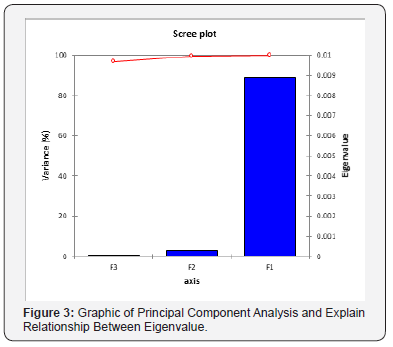
Factor loading analysis:However, principal component
analysis was used to help determine various variables, using the
extract factor with eigenvalue > 1 after varimax rotation. The results
of PCA, including eigenvalues with a varimax rotation and
the factor loadings, are classified in (Table 2) and (Figure 3), there
are three of the eigenvalues were found to be >1 (Figure 3). While
the total variance for these factors are about (99.60%), and two
of the eigenvalues were found to be ˃ 1 and the total variance for
the two factors (F1 and F 2) are about (99.60%), as in the (Figure
4). Otherwise, we applied the coefficient of correlation between
all environmental variables and factors, and the correlation coefficient
is bound to the range of ± 1, the +1 value inform us that
the points (xi, yi) determine a straight line with a positive slope, a
value of -1 inform us that it specify a straight line with a negative
inclination, while the value 0 indicates that there is no correlation
of y on x or vice versa.
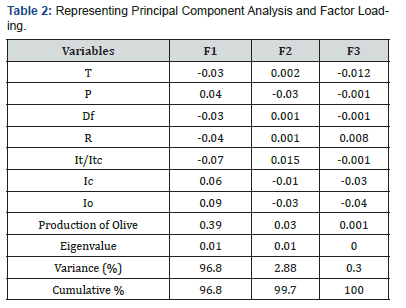
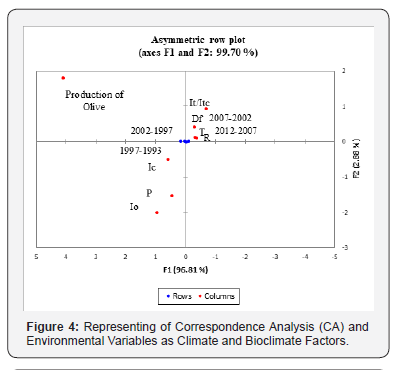
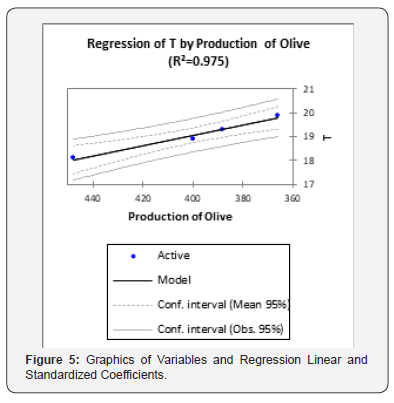
The factor 1 was dominated positively by the factors of precipitation
(0.04), simple continentality index (0.06), and annual
omrothermic index (0.09), except water deficit, compensated
thermicity index, and mean monthly temperature are dominated
negatively (-0.03, -0.07 and -0.03) and accounts for 96.8% of the
total variance and cumulative (Figure 4). Factor 2 is a high dominated
by mean monthly temperature (0.002), soil water reserve
and deficit water (0.001), compensated thermicity index (0.015),
while precipitation (-0.03), simple continentality index (-0.01),
and annual omrothermic index (-0.03) were dominated negatively.
Factor 3 is a dominated positively by soil water reserve (0.008),
but with negatively impact for the rest of factors, as reported in
the (Table 2).On the other hand, when we applied a correspondence analysis
(CA), observed that Jerusalem affected negatively by annual
ombrothermicindex and simple continentality index as the bioclimate
factors and precipitation as climate factors during the
years (1993-1997) because its lies in the negative y-axis (Figure
4), whereas, the effect was positive during the years of study from
(1997-2012), with a large proportion of the variance explained
by axis F1 (96.81%), while axis F2 (2.88%) and symmetric plot
axes F1and F2 (99.60%), this is evident in (Figure 4). Otherwise,
the analysis of variance (ANOVA), with a 95% confidence interval
has been applied to olive yield, with the seven environmental
variables (Tm or T, P or ppt, R, Df or Wdf, Io, Ic and It/Itc), explain
significant differences in olive production, impact of these factors
on the olive productivity. The results of the analysis for each of
regression coefficient, standardized coefficient, and adjusted R²
showed that there was a difference significance in this study, in
case of olive productivity shows a better regression coefficient
with value of mean monthly temperature and compensated thermicity
index (R2 = 0.975 and 0.912), adjusted R² (R2 = 0.962 and
0.868) respectively, being closed to 1 (Figure 5 & 6), and negatively
with the standard coefficient (-0. 978 and -0.955), because the
histograms were negative (Figure 7 & 8); precipitation is a better
linear regression or regression coefficient and adjusted R² with
the values of (R2 = 0.968, 0. 952) respectively, being closed to 1
(Figure 9), and correlated positively with the standard coefficient
(0.984), because the histograms is positive (Figure 10), and the
rest of variables and regressions values as tabulated in the (Table
3).
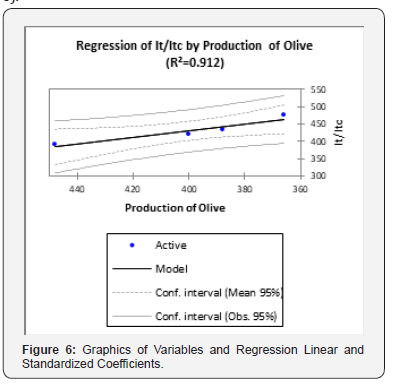
Olive in jerusalem
Jerusalem known by other names in Arabic such as: Biet
Al-Magdis, Al-Quds Al-Sharif, and the old city of Jerusalem was
known in the city of Zeitoun. Historically, their ancestral ancestors
the Jebusites were the first to build and inhabited the city inthe fifth millennium BC. Now, the most important olive growing
areas in Jerusalem: Beit Hanina, Beit Safafa, Kafr Aqaba, Shuafat,
Jabel Mukaber, the French Hill, Jabal Al-Musharraf, Sheikh Jarrah,
Wadi Al-Joz, Old City, Sur Bahir, Silwan, and Mount of olives (East
Jerusalem) (Figure 11). Mount Olive or Tur is one of the oldest
Palestinian villages in Jerusalem, located east of the Old City of Jerusalem,
the Mount of Olives is the highest area in Jerusalem with
a height of 826 meters above sea level and other areas in West Jerusalem
have been under Israeli control since 1948, although they
now control all areas of East and West Jerusalem. The area of olive
trees (rainfed) Palestine was 893,721 dunums, and the productivity
was 92kg/dunum, while the city of Jerusalem (East Jerusalem)
was area of about 11,664 dunums, production (1400ton), and productivity
was about 120kg/dunum during 2007/2008 [37], while
the olive productivity in Jerusalem amounted to about 100.5kg /
dunum during the year 1993-2012. The main olive varieties used
in the Palestinian territories are: Shamali, Jabbah, Mantelino, Nabali
Baladi, Nabali Mohsen, Shami, Suri, and Rumi [8,38].

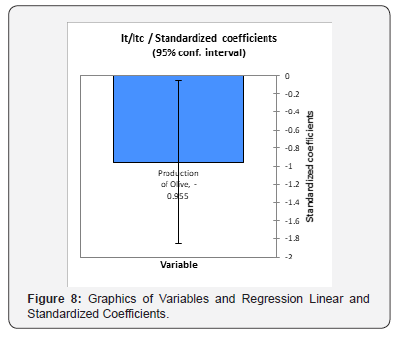
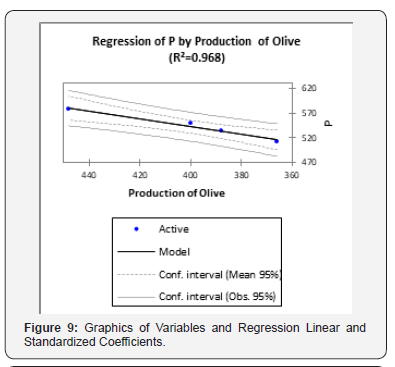
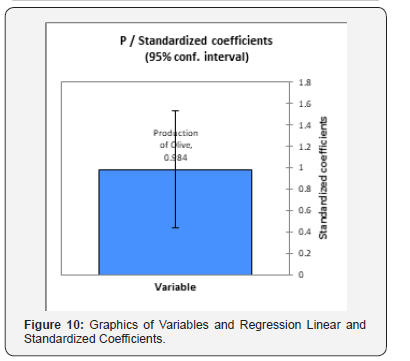
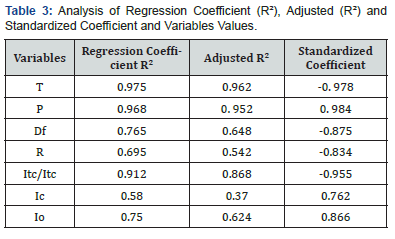
Impact of temperature on olive
The temperature has a significant impact on the
production
[39], physiology [11-13], biology and sustainability of plants [40-42],
where the olives growth need a cold period between 400-600
hours yearly, the starting temperature of olive growth is between
11-12°C, the optimal temperature for the growth of the olive tree
ranging between 18 -20°C [4,5], the formation of clusters of fruitsat
15°C, flowers bloom starting at 19°C, the fruit contract occurs
at 21°C, and the ripening temperature of fruits ranges from 35-
40°C, while the best storage temperature is between 10-15°C., as
reported in the (Table 4).
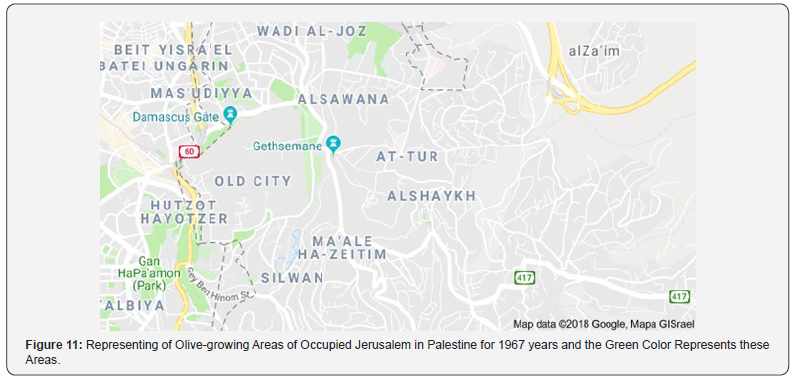
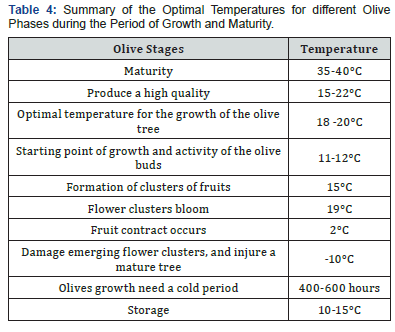
Conclusion
Olive has a great economic importance that affects the Palestinian
society as the largest and most important crop of fruit quarry
in terms of area, number and production. The olives were found
in Jerusalem and Palestine from more than 6,000 years ago, and
it is believed that Palestine is the world’s olive origin and were
mentioned in the Quran seven times. On the other hand, when
we used a correspondence analysis (CA), observed that Jerusalem
affected negatively by bioclimate factors as annual ombrothermicindex
and simple continentality index during the years
(1993-1997), whilst, the effect was positive during the years of study from (1997-2012), with a large proportion of the variance
explained by axis F1 (96.81%), while axis F2 (2.88%) and axes
F1and F2 (99.100%). However, in Jerusalem, the optimum of mean
monthly temperature for increased olive production is between
15-200C, precipitation more than (600mm), with the result of annual
ombrothermic index value more than 3.5, compensated thermicity
index (210/210 to 350/350), simple continentality index
between (15-20). Addition to olive production favor, where the environmental
areas thermomediterranean to mesomediterranean
of thermotype and dry to humid of ombrotype, and Jerusalem is
belonging to mesomediterranean of thermotype and dry to sub
humid of ombrotype.
To Know More About Trends in Technical and
ScientificResearch Please click on:
https://juniperpublishers.com/ttsr/index.php
To Know More About Open Access
Journals Please click on:



Comments
Post a Comment